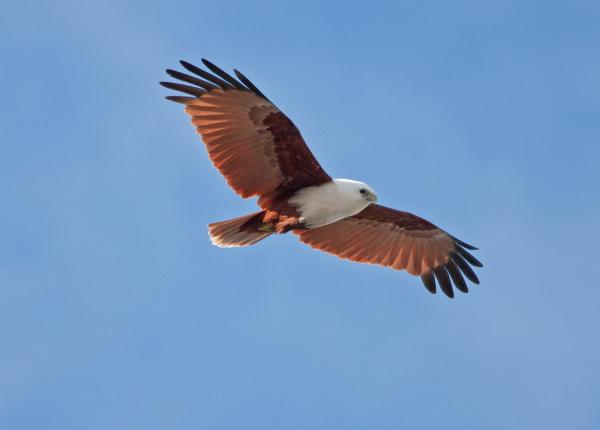Did You Know?
- The Brahminy Kite is also known by a few other names including Red-backed Kite, Chestnut-white Kite, and Rufous Eagle.
- This kite is known to harass other raptors when they have prey, in order to get them to drop their food, so the kite can quickly snatch it up.
How The Peregrine Fund is Helping
Though The Peregrine Fund doesn't work directly with the Brahminy Kite, our efforts in scientific research, habitat conservation, education, and community development help conserve birds of prey around the world. We also supply literature to researchers from our avian research library, which helps scientists around the world gather and share important information on raptor conservation. In addition, our Global Raptor Impact Network gives raptor researchers tools to more efficiently conduct their own studies while contributing to a global program. GRIN also provides citizen scientists a way to participate in raptor science and conservation.
Where it Lives
This species is found through parts of Asia, Australia, and New Guinea. It can be found soaring over coastal areas, estuaries, wetlands, rivers, swamps, and clearings. It often hunts over forest canopy.
What it Does
When it is not soaring, this beautiful kite spends its time on exposed perches in trees. It spends time alone, in pairs, and in small family groups. At night, it will sometimes roost in large groups.
Why it Needs our Help
This species is categorized globally as a species of "Least Concern" by BirdLife International. It is fairly common throughout its range.
What it Eats
Like most kite species, the Brahminy Kite has quite a long list of items on its menu. It will feed on small birds, fish, and insects, which it snatches from the surface of water or from foliage.
When hunting, this kite employs a few different techniques. It might soar low over mudflats and beaches as it keeps its eyes out for fish that are floating near the surface of the water or stranded. It will often take small prey in flight, which it often consumes while on the wing, meaning it eats while still in flight. It regularly scavenges around harbors and trash dumps and it is attracted to grassland fires, snatching up young birds, amphibians, and other animals fleeing the flames and smoke. It is also known to feed on carrion.
Nest, Eggs, and Young
Brahminy Kites build a large platform nest of sticks which they line with twigs, bark, leaves, dried mud or dung. They often build the nest between 2-30 m above the ground in a prominent fork of a tall tree. They seem to prefer forested slopes for nesting.
Pairs will often use the same nests year after year, adding new material each year. As a result, the nests become larger and larger over time. When the time is right, the female will lay between 1-3 eggs, which are white with small brown spots. Incubation lasts about 35 days. Once the nestlings hatch, they will grow quickly, flying for the first time when they are around 50-56 days old. The young will remain in their parents' territory for about two months as they learn to hunt, avoid danger, and otherwise survive on their own.
Brahminy Kite and the World Center for Birds of Prey
The World Center for Birds of Prey offers fun ways to learn about all birds of prey. Interactive activities, tours, interesting videos, and a children's room with activities from coloring sheets to quizzes to costumes await you. The visitor center has many live raptors on display, and in the fall you can observe some of the raptors showing off their flying skills during our Fall Flight Shows. This is a great chance to see birds of prey up close and learn about the wonderful and interesting adaptations they have in order to survive in their respective habitats. There is also a touch table with feathers and other natural objects available for exploration. Our knowledgeable staff is on hand year-round to answer any questions you may have about the Brahminy Kite or any other bird of prey.
References:
Debus, S., T. S. David, J. S. Marks, and G. M. Kirwan (2021). Brahminy Kite (Haliastur indus), version 1.2. In Birds of the World (P. Pyle, Editor). Cornell Lab of Ornithology, Ithaca, NY, USA. https://doi.org/10.2173/bow.brakit1.01.2
Global Raptor Information Network. 2022. Species account: Brahminy Kite Haliastur indus. Downloaded from http://www.globalraptors.org on 25 Jun. 2022










